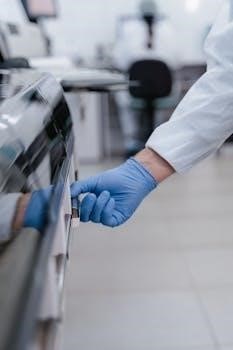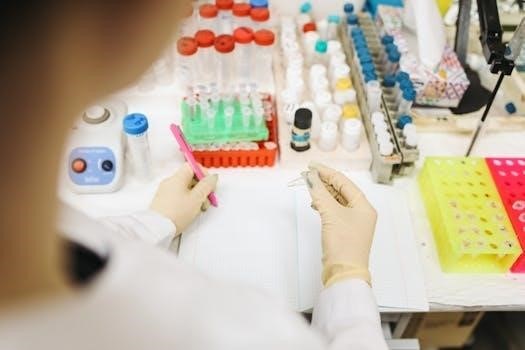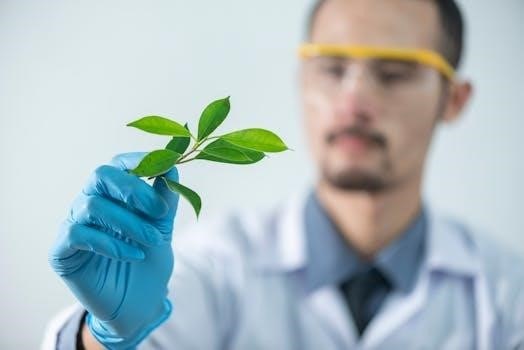AP Biology Unit 3 Test⁚ Overview
This unit focuses on cellular energetics, covering crucial topics like enzymes and their functions, cellular energy, and the processes of cellular respiration and photosynthesis, all vital for the AP Biology exam.
Key Concepts of Unit 3⁚ Cellular Energetics
Unit 3 delves into the core principles of cellular energetics, exploring how cells manage energy through various biochemical pathways. This includes a detailed study of enzymes, their structure, function, and specificity, as well as the factors that influence their activity. The unit also covers the fundamental concepts of catabolic and anabolic reactions, and how exergonic and endergonic reactions contribute to energy transformations within the cell. Furthermore, students will learn about cellular respiration, including glycolysis, the link reaction, the Krebs cycle, and the electron transport chain, and how these processes generate ATP. Finally, the basic principles of photosynthesis and its role in energy production are also explored, providing a comprehensive understanding of how cells obtain and utilize energy. This unit also introduces the fitness aspects that relate to the use of energy in the biological world. The exam will test all these concepts.
Enzymes and Their Function
Enzymes are essential biological catalysts that facilitate biochemical reactions by lowering activation energy. They exhibit high specificity, binding to specific substrates at their active sites.
Enzyme Specificity and Active Sites
Enzymes are renowned for their remarkable specificity, a characteristic stemming from the unique three-dimensional structure of their active sites. This specificity dictates that an enzyme will typically bind to only one particular substrate or a small group of structurally similar substrates. The active site, a region within the enzyme, is where the substrate binds, forming an enzyme-substrate complex. This interaction is often described using the lock-and-key model, where the substrate perfectly fits into the active site like a key in a lock. However, the induced fit model better explains the dynamic nature of the active site, which slightly changes shape to accommodate the substrate. This precise binding ensures that enzymes catalyze specific reactions with high efficiency. The active site’s unique shape, defined by its amino acid sequence and folding pattern, also determines the type of chemical reaction the enzyme can facilitate. This specificity is crucial for the coordinated functioning of metabolic pathways within cells. Enzymes are highly specific due to their active site.
Factors Affecting Enzyme Activity
Enzyme activity is influenced by several factors, including temperature, pH, and the presence of inhibitors or cofactors. Temperature affects the rate of enzyme-catalyzed reactions. As temperature increases, the rate typically rises until reaching an optimum point; beyond this, excessive heat can denature the enzyme, disrupting its structure and function, causing a decrease in activity. Similarly, each enzyme has an optimal pH range. Extreme pH conditions can also denature enzymes by altering the ionic interactions that maintain their shape. Inhibitors, either competitive or non-competitive, can reduce the rate of enzyme activity. Competitive inhibitors bind to the active site, preventing substrate binding, while non-competitive inhibitors bind elsewhere, altering the enzyme’s shape and preventing proper function. Cofactors, on the other hand, are inorganic ions or organic molecules essential for enzyme activity. Their presence can enhance the enzyme’s ability to catalyze reactions. These factors collectively control the rate and efficiency of enzyme-catalyzed reactions in cellular processes.

Cellular Energy
Cellular energy explores how cells manage energy through metabolic reactions, focusing on the principles of thermodynamics, crucial for understanding energy flow in biological systems.
Catabolic and Anabolic Reactions
Catabolic reactions are crucial for breaking down complex molecules into simpler ones, releasing energy in the process; this includes processes such as hydrolysis and cellular respiration. These reactions are vital for providing the energy needed for cellular activities. Conversely, anabolic reactions involve building complex molecules from simpler ones, a process that requires energy input. Think of protein synthesis and photosynthesis, as examples of anabolic reactions. These reactions are essential for growth, repair, and the storage of energy within cells. The interplay between catabolic and anabolic pathways ensures a balanced energy flow within living organisms. Both types of reactions are fundamental to cellular metabolism. In essence, catabolism provides the fuel, while anabolism utilizes it to construct and maintain biological structures, and both are essential for life.
Exergonic and Endergonic Reactions
Exergonic reactions are those that release energy, meaning they have a negative change in free energy (ΔG < 0). These reactions often occur spontaneously and include processes like cellular respiration. Conversely, endergonic reactions require an input of energy to proceed, resulting in a positive change in free energy (ΔG > 0). Examples include photosynthesis and protein synthesis. These reactions are non-spontaneous and need energy to drive them. Essentially, exergonic reactions provide the energy that drives endergonic reactions within cells. The coupling of exergonic and endergonic reactions is essential for maintaining cellular processes. The overall energy balance within the cell is a result of the interplay between these two fundamental types of reactions. Therefore, understanding the difference is crucial for understanding cellular metabolism.

Cellular Respiration
Cellular respiration is a vital process where cells convert glucose into ATP, the primary energy currency. This process involves glycolysis, the Krebs cycle, and the electron transport chain.
Glycolysis, Link Reaction, Krebs Cycle
Glycolysis, the initial stage of cellular respiration, occurs in the cytoplasm, breaking down glucose into pyruvate. This process yields a small amount of ATP and NADH. Following glycolysis, the link reaction, which takes place in the mitochondrial matrix, converts pyruvate into acetyl-CoA, releasing carbon dioxide. The Krebs cycle, also in the mitochondrial matrix, further oxidizes acetyl-CoA, producing more carbon dioxide, ATP, NADH, and FADH2. These stages are crucial for generating high-energy electron carriers that will be used in the electron transport chain. Each step is carefully regulated, ensuring that the cell’s energy needs are met efficiently. Understanding these processes is essential for comprehending how cells generate energy and for success on the AP Biology Unit 3 test. These processes are interconnected, forming a metabolic pathway that extracts energy from glucose.
Electron Transport Chain and ATP Production
The electron transport chain (ETC), located in the inner mitochondrial membrane (cristae), is the final stage of cellular respiration, where the majority of ATP is produced. High-energy electrons from NADH and FADH2, generated in previous steps, are passed along a series of protein complexes. This electron flow creates a proton gradient across the inner mitochondrial membrane. The potential energy stored in this gradient is then used by ATP synthase to produce ATP through oxidative phosphorylation. This process is highly efficient, yielding a significant amount of ATP compared to glycolysis and the Krebs cycle. Understanding the mechanisms of the ETC and ATP production is crucial for mastering cellular respiration; It’s vital to grasp how electron carriers, proton pumps, and ATP synthase work together in this crucial energy-generating process. These components are fundamental to understanding how cells convert chemical energy into usable forms.

Photosynthesis
This section will cover the fundamental principles of photosynthesis, the process by which plants and other organisms convert light energy into chemical energy, focusing on key reactions and concepts.
Basic Principles of Photosynthesis
Photosynthesis is a vital process where light energy is converted into chemical energy, fueling most ecosystems. This process primarily occurs in chloroplasts, utilizing chlorophyll to capture sunlight. The basic equation involves water and carbon dioxide being transformed into glucose and oxygen. Understanding the light-dependent and light-independent reactions, including the role of ATP and NADPH, is crucial. Key aspects include the thylakoid membrane, where light reactions take place, and the stroma, where the Calvin cycle occurs. These principles are fundamental for grasping how energy flows through biological systems. Furthermore, the implications of photosynthesis extend to global cycles of carbon and oxygen, making it an essential topic for AP Biology.

Practice and Assessment
To prepare for the AP Biology Unit 3 test, utilize multiple-choice questions, practice tests, and quizzes. These resources help solidify understanding and improve performance on the exam.
Types of Practice Questions (Multiple Choice)
Multiple-choice questions are a fundamental part of the AP Biology Unit 3 test, assessing your grasp of core concepts related to cellular energetics. These questions often require you to apply knowledge of enzyme structure and function, including enzyme specificity and active sites. You’ll encounter questions focusing on factors influencing enzyme activity such as temperature and pH. Expect questions covering catabolic and anabolic reactions, and the distinction between exergonic and endergonic processes. Furthermore, practice questions will delve into the intricacies of cellular respiration, including glycolysis, the link reaction, the Krebs cycle, and the electron transport chain, focusing on ATP production. Photosynthesis is another area of focus, requiring understanding of its basic principles. Many practice questions will be similar to those found in AP exams, designed to test your problem-solving skills and your ability to recall specific facts. They are crucial for reinforcing what you have learned and highlighting areas needing more attention.
Resources for Practice Tests and Quizzes
Numerous online resources offer practice tests and quizzes to help you prepare for the AP Biology Unit 3 exam. Websites like Quizlet provide flashcards and practice multiple-choice questions focusing on cellular energetics, including enzyme specificity and metabolic reactions. Platforms like Varsity Tutors offer extensive question banks organized by topic, with answers and explanations, which are very helpful in understanding the reasoning behind the correct choices. Many other educational websites provide full-length practice tests that mimic the actual AP exam format, helping students familiarize themselves with the timing and types of questions to expect. You can also find practice questions on College Board’s website, along with free response questions. Additionally, consider using review books and textbooks that often include practice tests and quizzes at the end of each chapter. By utilizing these resources, you can better assess your understanding and pinpoint areas for improvement.




Leave a Reply
You must be logged in to post a comment.